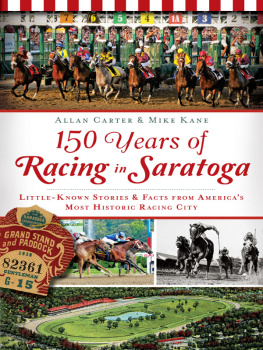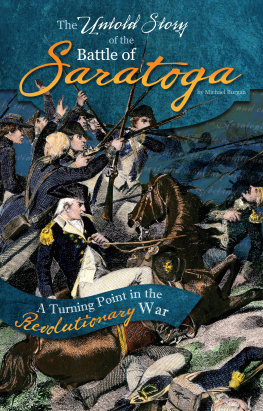
Published by The History Press
Charleston, SC 29403
www.historypress.net
Copyright 2013 by Allan Carter and Mike Kane
All rights reserved
First published 2013
e-book edition 2013
Manufactured in the United States
ISBN 978.1.62584.555.9
Library of Congress CIP data applied for.
print edition ISBN 978.1.62619.102.0
Notice: The information in this book is true and complete to the best of our knowledge. It is offered without guarantee on the part of the author or The History Press. The author and The History Press disclaim all liability in connection with the use of this book.
All rights reserved. No part of this book may be reproduced or transmitted in any form whatsoever without prior written permission from the publisher except in the case of brief quotations embodied in critical articles and reviews.
To our friend Richard L. Hamilton, a man of many interests and talents: voracious reader, teller of stories, expert on racing silks, insufferable fan of the Red Sox, mentor, comedian, historian, language maven, kind and caring person and lifelong fan of Thoroughbred racing.
Gone, but certainly not forgotten.
Contents
Preface
While there were deadlines, there was no start date to this project. It began to happen during the nearly five years we spent together at the National Museum of Racing and Hall of Fame. During our many conversations, we talked about creating a book together some day.
The concept we agreed on was to write about subjects that interested us and might entertain readers. Hugh Bradley, Ed Hotaling, Mike Veitch and other authors have turned out fine histories of racing in Saratoga Springs, so there was no need for another. We decided to give the often-told Saratoga stories a pass and focus on little-known subjects that might have been overlooked or given scant coverage. That opened the door for chapters about Los Angeles and Checkmate, Saratoga owner Gottfried Walbaum, firsts at the track, some of the great matchups, the reasons that led to the track being closed for a total of six seasons and stats from the decades before the New York Racing Association (NYRA) bought the track.
Allan and I have a few things in common. We are natives of the nearby city of Glens Falls who had little to do with racing in our youth but embraced the sport as adults. We have a love of history and enjoy researching, writing and talking about the past. For Allan, the introduction was as a fan in the late 1960s; mine was as a journalist at the end of the 70s. We came to appreciate that we were raised, work and live close to Americas greatest racetrackso close, in fact, that Allan walks to the track most every day of the meeting.
We were introduced one morning in April 2005 by our mutual friend Richard Hamilton. Allan had succeeded the legendary Tom Gilcoyne, who had decided as he approached ninety that it was time to retire as the historian at the National Museum of Racing. Hamilton was sliding into retirement, too, and I was taking over his position as the communications officer.
Thanks in no small part to Allans persistence, eight years later there is another Saratoga book to add to the library.
MIKE KANE
Acknowledgements
Two names are on the cover, but this book could not and would not have been written without the help of many other people.
At the top of our long list of people to thank is Chris Dragone, director of the National Museum of Racing and Hall of Fame, for his enthusiastic encouragement and for giving us carte blanche in our use of the museums images. A special thanks goes to Arianna Galluzo, assistant curator at the museum, for the countless hours she spent providing us with the photos we requested and scanning the ones we selected. It was a lot of work, and she did it with a smile.
Others who assisted us in acquiring the images we wanted were Teri Blasko and Victoria Garlanda of the Saratoga Room of the Saratoga Springs Public Library; Sam Hildebrandt of Friends of Sanford Stud Farm; longtime California racing photographer Bill Mochon; NYRA photographers Adam and Bob Coglianese, whose family has been recording racing history for decades; Cathy Schenck and Amy Petit of the Keeneland Library; Jamie Parillo of the Saratoga History Museum; the National Museum of Racings Brien Bouyea; and Minnie Bolster, who has witnessed and recorded many decades of life in Saratoga Springs.
Bill Cavanagh, Jim Sweet and Joe Peck put in countless hours as research volunteers in the library at the racing museum, and their dedication yielded the trove of statistics published for the first time in these pages. In Kentucky, Bill Mooney, Ed Bowen and Rhonda Norby promptly found the answers to some vexing research questions.
Jim Melia, Mike Veitch, Joe Cacciolfi and Bob Curran graciously offered time to proofread what we had written, keeping our howlers to a minimum.
The late Mike Burke was able to return to his hometown for his final years and became a close friend, inspiration and source of ideas and information. His research proved to be invaluable. We still regret his premature passing.
Thanks, of course, to Whitney Landis at The History Press, a native of Saratoga Springs, who made it possible for this book to be published, as well as to her colleagues for getting everything together.
Finally, we would like to thank our wives, Paula Carter and Kathy Kane, for their support and patience and, in Paulas case, for her IT assistance to her Luddite husband.
First Things First
The Thoroughbred racing era in Saratoga Springs began on Monday, August 3, 1863, with a pair of races on the trotting track on the north side of Union Avenue in what was later renamed Horse Haven. Eight races were contested over four days in that inaugural meet arranged by John Morrissey. Buoyed by the success of that experiment, Morrissey and his partners purchased acreage across the street and built a venue on the grounds of what is now Saratoga Race Course. There have been plenty of firsts since that 1863 launch. Here are several of note.
FEMALE JOCKEYS
Robyn Smith was the pioneer female rider at Saratoga Race Course, and she accomplished the double of the first ride and first victory.
Smith, an attractive woman with a somewhat mysterious past, made history on Monday, July 29, 1970, when she rode Embecias in the second race of the opening day card. Embecias, a three-year-old filly trained by Frank Wright, finished ninth in the ten-horse field of maiden claimers. The Saratogian gave it top-of-the-page coverage in the sports section.
Ive always wanted to go to Saratoga, Smith said. Riding here is a real privilege.

Jockey Robyn Smith was the first woman to ride at Saratoga and to win a race at the track. Courtesy of NYRA/Bob Coglianese.
Wright noted, Miss Smith definitely has some real ability. If any girl is going to make it as a result of application and effort, I think she might very well be the one.
Women broke through and started riding in pari-mutuel races in 1969, but no one reached the starting gate at Saratoga that summer. Two female riders tried, though. According to an Associated Press report in the Schenectady Gazette, Patty McDonald, the wife of steeplechase jockey Bob McDonald, was named on a horse that was scratched early in the meet. The New York Racing Commission prevented Ann Walsh from riding Safe Corner because her husband owned the horse and jockeys were not allowed to have a financial interest in their mounts.
Next page







